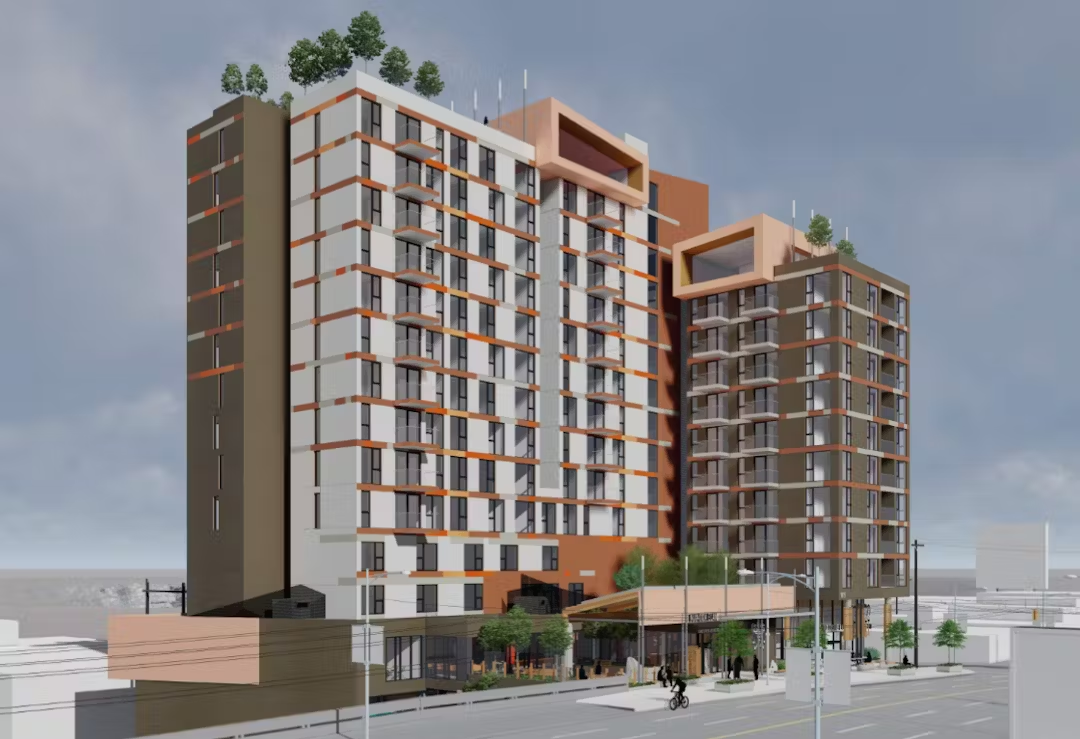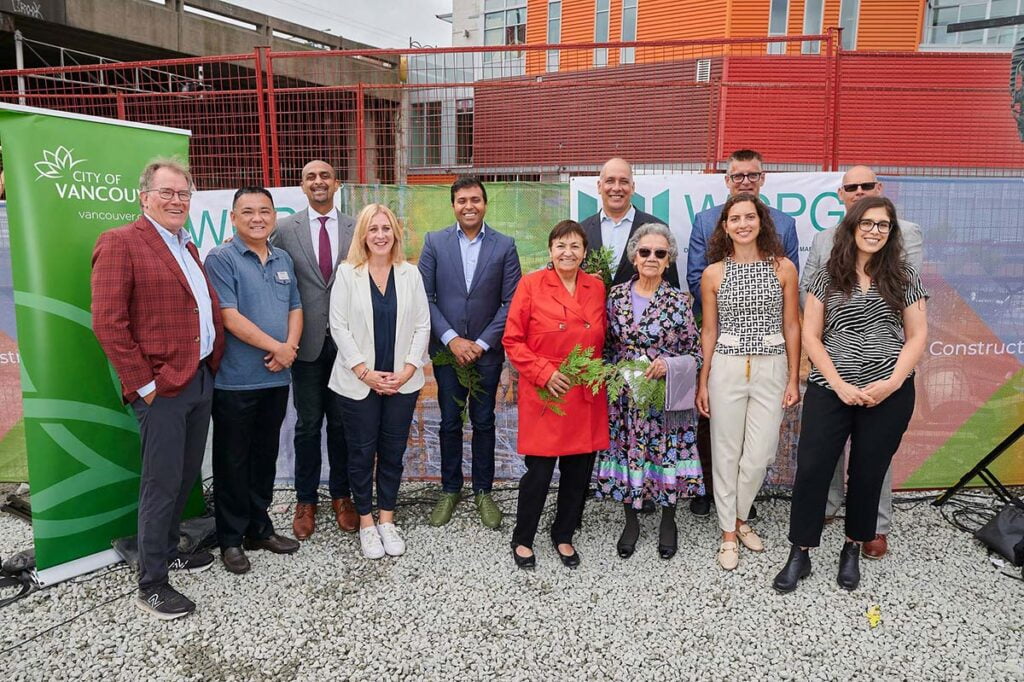A major new development is set to reshape Vancouver’s Downtown Eastside, bringing much-needed relief to one of the city’s most vulnerable communities. Ho’-kee-melh Kloshe Lum, an Indigenous-led, mixed-use housing project, will deliver 150 rental homes, 25 supportive housing units, and 80 shelter beds by late 2025. This landmark project represents more than just a housing initiative—it is a beacon of hope for the Downtown Eastside (DTES), a neighborhood long defined by poverty, addiction, and homelessness. Prioritizing Indigenous residents, the development aims to provide stability, cultural connection, and vital support services.
This isn’t just another project, but a lifeline for a community that has been historically neglected.
Ho’-kee-melh Kloshe Lum: A Game-Changer for the Downtown Eastside
Located at 1607 East Hastings Street, Ho’-kee-melh Kloshe Lum, meaning “to gather, good spirits,” will offer more than just affordable housing. The cojoined towers will cater to larger Indigenous families, with family-oriented homes, ceremonial spaces, and crucial support services integrated into the design. It’s a holistic approach that recognizes the deep-rooted social and cultural challenges facing the DTES, where Vancouver’s highest concentration of Indigenous Peoples resides.
Led by the Vancouver Aboriginal Friendship Centre Society (VAFCS), the project has been over a decade in the making. In 2009, Susan Tatoosh, executive director of VAFCS, spearheaded the push for this development, recognizing that traditional housing solutions weren’t enough to address the systemic issues impacting Indigenous communities in the DTES. VAFCS, a cornerstone of the East Hastings community, has long offered services like health programs, cultural education, and human rights advocacy, but this development will take their mission to a new level.
Housing projects like Ho’-kee-melh Kloshe Lum are not just a response to the housing crisis—they’re a blueprint for how Indigenous-led solutions can address the unique needs of marginalized communities.

A Collaborative Effort with Big Impact
The $97-million project is backed by a coalition of local, provincial, and federal partners. Funding sources include $57.27 million from BC Housing, with $34 million coming through the Supportive Housing Fund and an additional $23 million from Affordable Rental Housing grants. The federal government has committed $22 million, and the City of Vancouver has contributed $4.6 million in grants and fee waivers, along with the land, valued at $13.3 million, under a nominal-fee leasehold agreement.
This partnership—between BC Housing, Canada Mortgage and Housing Corporation (CMHC), Indigenous Services Canada, the City of Vancouver, and the Aboriginal Housing Management Association (AHMA)—represents a significant shift towards Indigenous-led urban housing solutions. This development isn’t just a building; it’s a symbol of what can be achieved when different levels of government come together with community-driven organizations to address deeply rooted social issues.
The inclusion of supportive housing, a ceremonial space, and services like the Klatawa DIY bike shop and café will not only meet the basic needs of residents but also empower them to build better lives. This development is designed to support individuals holistically, providing more than a roof—it will offer dignity, community, and hope.
Tackling BC’s Housing Crisis
Ho’-kee-melh Kloshe Lum is part of a broader strategy by the BC government to tackle housing shortages. Since 2017, the provincial government has poured $19 billion into housing, delivering or working on over 76,000 homes, including nearly 8,000 in Vancouver alone. But Indigenous-led projects like this are particularly vital in addressing the unique housing challenges faced by Indigenous communities in both urban and rural settings.
The Building BC: Indigenous Housing Fund (IHF) is another critical piece of this puzzle. With a $1.7-billion budget, the IHF has been instrumental in delivering affordable housing specifically for Indigenous people, both on and off reserves. To date, the program has led to the development of 3,220 homes across the province, with more than 1,600 new homes on the way. BC is the only province to invest in on-reserve housing, which is typically under federal jurisdiction, marking a significant policy shift and demonstrating a commitment to Indigenous housing needs.
This project and others under the IHF underscore a new era of Indigenous-led housing development. Organizations like the Aboriginal Housing Management Association (AHMA) are at the forefront of this movement, managing over 95% of off-reserve Indigenous housing in BC AHMA’s role as a “for Indigenous, by Indigenous” housing authority is a groundbreaking model for empowering communities and addressing the deep inequalities faced by Indigenous populations.
The Broader Impact on Vancouver’s Housing Landscape
For a long time, Vancouver’s Downtown Eastside has been a symbol of government failure—an area rife with homelessness, addiction, and overcrowded shelters. The Ho’-kee-melh Kloshe Lum development, however, signifies a turning point. By prioritizing Indigenous residents and delivering a mix of supportive housing, affordable rentals, and shelter beds, the project is set to create lasting, meaningful change in the area.
Vancouver Mayor Ken Sim was straightforward about this development’s impact: “Ho’-kee-melh Kloshe Lum is an innovative, Indigenous-focused, and community-driven partnership that will bring much-needed below-market, supportive and shelter housing to the Downtown Eastside.” His words point to the broader vision for the city—one where Indigenous-led solutions can play a crucial role in alleviating the housing crisis and addressing systemic inequalities.
The benefits of this development extend beyond the DTES. As housing costs continue to skyrocket across Vancouver, developments like Ho’-kee-melh Kloshe Lum could serve as a model for approaching housing affordability across the city. It’s not just about building more units; it’s about creating the right kind of housing that addresses vulnerable communities’ economic and social needs.
The Future of Indigenous-Focused Housing in BC
British Columbia has set a high standard with its commitment to Indigenous-focused housing solutions. The partnerships formed and the projects underway demonstrate a recognition that the housing crisis cannot be solved without addressing the unique needs of Indigenous populations. Ho’-kee-melh Kloshe Lum is a symbol of what can be achieved when Indigenous voices lead the way.
More Information
BC’s new Homes for People action plan
Information about Canada Mortgage and Housing Corporation
Denise is a long-time advocate for affordable and dignified housing in the Downtown Eastside. Having lived in SROs and volunteered in homeless shelters, she brings a personal understanding of the housing crisis and its impact on the community. Her work reflects years of lived experience, frontline work, and commitment to creating better living conditions for DTES residents.







Leave a Comment